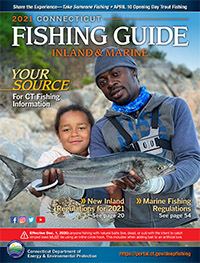Welcome to Connecticut Fishing

Greetings fellow fishing enthusiasts!

I’m a life-long avid fisherman, but during this recent tumultuous year, fishing took on extra importance for me as a way to escape stressful everyday realities and spend safe quality time recreating with my family. I am not the only one; all available information suggests 2020 was a banner year for participation in outdoor recreation like fishing, with many people either trying their hand at it for the first time, or rekindling a previous interest. To all of you in this group I say: Welcome (or Welcome Back)! I hope you will continue to make fishing a part of your life and even help grow our ranks by sharing your enthusiasm and experiences with others.
A look across the Connecticut saltwater fishing landscape in 2021 reveals a mixed bag of opportunities and challenges. On the positive side, populations of scup and black sea bass remain at all-time highs. These bottom-dwelling fish can be found just about anywhere in Long Island Sound, are easy to catch, and if you’re so inclined can provide a delicious and healthy meal. If you’re looking to get in on this great fishing opportunity, consider booking a bottom fishing trip on a Connecticut charter boat or headboat. These boats provide a safe and easy way for you and your family to enjoy some great fishing action (and they’ll even clean the fish for you). The current outlook for some of our other iconic marine sportfish are not quite as rosy; Striped Bass, Bluefish, and Tautog (Blackfish, ‘Tog) have all been declared “overfished” by regional fishery management authorities, and as a result Connecticut has implemented more conservative regulations in recent years, which will remain in place for 2021. I am very optimistic that these tough but necessary adjustments will bear fruit and help return these species to higher numbers. But make no mistake — in the meantime, there are plenty of opportunities to catch stripers, blues, and ‘tog in Connecticut waters. A great source for some tips to improve your odds is your local bait & tackle shop. They spend all day hearing customer fish stories (some of which are even true) and can point you in the right direction.
In closing, I’ll highlight one way in which you can take direct personal action to improve the future outlook for Connecticut fishing. Catch-and-release is becoming an increasingly prevalent practice, which is great — but how you go about it can make a big difference to your impact on the resource. Use of proper tackle and good fish handling practices can greatly increase the odds of a fish surviving post-release (see within this Guide and our DEEP Fishing Webpage for more details). This was the motivation for Connecticut and other coastal states to adopt a new rule in 2021 requiring the use of inline circle hooks when bait fishing for striped bass. Circle hooks are scientifically proven to reduce hooking injury and improve post-release survival. Consider adopting the use of circle hooks and other best practices into your own catch-and-release fishing; the fish will thank you and so will future Connecticut anglers.
Wishing you fair winds, following seas, and tight lines in 2021.
Justin Davis
Assistant Director, Fisheries Division
Invasive Species Alert— Coventry Lake & Connecticut River
In 2016, DEEP began funding (in collaboration with the Town of Coventry) management efforts (including a series of surveys and a herbicide treatment) with the goal of eradicating hydrilla in Coventry Lake. It is expected that this management (surveys, herbicide treatments) will be ongoing for several more years. Unfortunately, also in 2016, hydrilla was found in the Connecticut River. First in a difficult to access portion of Keeney Cove in June, and then in September DEEP staff observed several patches of hydrilla mixed in among the aquatic plants growing in the mainstem river at Glastonbury’s Riverfront Park and Boathouse. It appears that hydrilla has been in the Connecticut river for a couple of years and it has since dispersed throughout the river in Connecticut. As a result, eradication is likely not practical. All resource users should take extra care to check and clean their boats (including canoes, kayaks and rowing sculls), trailers, and fishing equipment before leaving the boat launch, or leaving the lakeshore.
Información disponible en español relacionada con la pesca en Connecticut — https://portal.ct.gov/DEEPCARE
Los folletos de la pesca en aguas dulces y aguas saladas fuerón traducidos al español para la distribución a la comunidad hispana residente en Connecticut. El objetivo de los folletos de pesca en español es para ayudar a fomentar, aumentar, y promover la participación hispana en esta actividad. Somos afortunados en Connecticut por el gran abastecimiento de peces. La población de Connecticut tiene la oportunidad a pescar a no más de 5 millas de su residencia. Las aguas dulces de Connecticut le ofrece pescar peces tales como la Trucha, la Lobina, el Lucio Norteamericano, y el Panfish. Si su preferancia es pez de agua salada, las aguas de Connecticut le ofrece pesca peces tales como la Lobina Rayada, Summer Flounder, Anjona, y Porgy. ¡Vamonos a Pescar!
